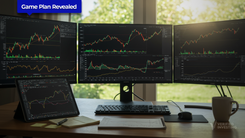My Trading Game Plan Revealed - 10/28/2025: M2 Signals NASDAQ Peak as Fed Decision and Mega Tech Earnings Loom

The next 48 hours could define the market's trajectory for the remainder of the year. As traders brace for a trifecta of high-impact events—a Federal Reserve decision, a deluge of mega-cap tech earnings, and a pivotal U.S.-China trade meeting—the indices are stretched at critical technical levels. In this morning's My Trading Game Plan, Gareth Soloway, Chief Market Strategist at Verified Investing, unveiled a stunning correlation between the NASDAQ and the M2 money supply that suggests we may be on the cusp of a historic inflection point.
A Week of Reckoning
The market is currently in a state of suspended animation, melting up into what is arguably the most condensed and significant event calendar of the year. On Wednesday, all eyes will be on the Federal Reserve and Chairman Jerome Powell. While a 25-basis point interest rate cut is widely expected, the true market-moving information will come from the subsequent press conference.
"Is it hawkish? Is it dovish? What's the commentary on the potential bubble in the markets? Does he think it's a bubble? Does he warn people about that?"
These are the questions Gareth posed, highlighting the nuance that will drive algorithmic and institutional reactions. Just hours later, the market will have to digest earnings from titans of industry: Meta, Microsoft, and Alphabet. As if that weren't enough, Thursday brings the highly anticipated meeting between President Xi and President Trump, where the fate of a formal trade deal hangs in the balance. The market has priced in a positive outcome, rallying significantly on the news that a framework is in place, but as history has shown, nothing is certain until the ink is dry.
X Marks the Spot for the S&P 500
Amid this fundamental storm, the technical picture for the S&P 500 is flashing a massive warning sign. The index is currently trading directly into a confluence of two major, long-term trend lines, creating a technical "X marks the spot" that is impossible for chartists to ignore.
The first trend line is a monumental support level connecting the absolute lows of the COVID crash in March 2020, the bear market bottom of 2022, and the correction lows of late 2023. The second, more steeply sloped line, connects the lows from October/November 2023, August 2024, and January 2025. Yesterday, the S&P 500 closed fractionally above this intersection, currently trading around the 6,920 level.
The critical question is not where the market is now, but where it will be after the dust settles on Thursday. A firm close above this zone could signal a major breakout, while a rejection could mark a significant top. For technicians, the importance of this level cannot be overstated. As Gareth emphasized, "For a technician, this is unbelievably big."
Has M2 Money Supply Predicted the NASDAQ Top?
While the S&P 500 chart is compelling, Gareth revealed a far more profound and potentially predictive analysis connecting the NASDAQ's current level to the expansion of the M2 money supply since the dot-com bubble. This is the kind of deep, data-driven analysis that separates casual observation from professional strategy.
Let's break it down:
- The Dot-Com Peak: In 2000, at the height of the dot-com bubble, the NASDAQ Composite peaked at approximately 5,125.
- M2 Money Supply Then: At that exact time, the M2 money supply (a measure of liquid money in the financial system) stood at $4.85 trillion USD.
- M2 Money Supply Now: Today, the M2 money supply has expanded to $22.5 trillion USD.
- The Multiple: This represents a 4.65x increase in the M2 money supply since the last major tech bubble peak ($22.5 trillion / $4.85 trillion = 4.65).
Now for the stunning conclusion. If we take the NASDAQ's 2000 peak and multiply it by the same factor that the M2 money supply has expanded, we get a precise target.
5,125 (NASDAQ 2000 Peak) x 4.65 (M2 Multiple) = 23,775
The NASDAQ is currently trading at 23,637. This analysis implies that the NASDAQ's entire rally since the dot-com bust is almost perfectly proportional to the expansion of money in the system, and we are now just 140 points from that calculated terminal point.
"Isn't this absolutely intriguing?… The expansion in M2 money supply is almost exactly the same amount as what the NASDAQ in multiples has gone up since one bubble burst at the highs to where we currently are."
This doesn't guarantee a top to the exact point, but it provides a powerful macro framework suggesting that the upside in tech may be far more limited than the AI narrative suggests. It raises the question: will we look back and realize the top had more to do with monetary limits than technological euphoria?
The Great Rotation into Value
If the high-flying tech sector is nearing a ceiling, where is capital likely to flow? The answer, according to Gareth, is already visible in the market's underbelly: a rotation into beaten-down, high-dividend-paying stocks. This trend is amplified by the fact that fund managers are nearly all-in on the market, with cash levels at a historic low of just 3.8%. With little new cash to deploy, managers are forced to sell winners to buy laggards.
"Money, it doesn't leave the market, right? When things get pricey in certain areas, it rotates. That's what capital fund managers do."
UPS provides a perfect case study. Before its explosive earnings report sent the stock from $89 USD to over $100 USD, it was trading at its COVID-era lows. This was a logistics giant, essential to the economy, priced as if the world was ending. This is the kind of deep value opportunity that emerges when one sector becomes over-loved. Other names like Keurig Dr. Pepper (KDP) and Pfizer (PFE) fit the same profile. Pfizer, for example, is trading near its COVID lows and pays a staggering 7% dividend yield in a declining interest rate environment. This makes its dividend even more attractive.
Contrast this with a stock like Royal Caribbean (RCL), which is also correcting after earnings. While RCL is down, it is falling from all-time highs. A stock like Pfizer is at multi-year lows. In a market-wide drawdown, the elevated names have much further to fall, while the beaten-down value plays offer a greater margin of safety.
Navigating Earnings Volatility
Earnings season is creating massive moves in individual stocks, and Gareth's analysis provides a clear road map for identifying key technical levels.
- FFIV: The stock gapped down from $288 USD to $261 USD after earnings. A clear bear flag pattern had formed leading into the report, signaling potential weakness. The first high-risk support level is a gap fill at $250 USD, with a more significant swing trade level around $229 USD.
- Cameco (CCJ): Soaring from $86.60 USD to over $100 USD on news of potential government contracts for new nuclear reactors. However, the stock is running directly into a long-term, up-sloping trend line that provides resistance around the $102 USD level, making it a potential short-term fade.
- PayPal (PYPL): The stock popped on decent earnings and an OpenAI partnership announcement. After hitting a pre-market high of $82.50 USD, it has pulled back. A key level to watch for a potential short trade would be the major gap fill at $86.45 USD.
Gold, Bitcoin, and Probabilistic Trading
The precious metals and crypto markets are also offering crucial signals.
Gold: The correction in gold is playing out exactly as anticipated, mirroring the 1979 price action. Gareth outlined a probabilistic approach to trading the pullback. The first support level, which has now been hit, had a 90% probability. The next level has a 75% probability, and the ultimate "golden buying opportunity" at $3,045 USD has a 50/50 chance of being reached. This tiered, probability-based system allows a trader to scale out of shorts and manage positions logically rather than emotionally. The topping signal was also anecdotal: reports of lines around the block to buy gold bars in Australia were a classic sign of public hysteria and a market peak.
Bitcoin: The leading cryptocurrency is struggling at a key technical juncture. After breaking below a critical trend line, it attempted to rally back above it yesterday. However, it failed to achieve a "confirmation close" above the line by the end of the day. For the bullish case to regain momentum, Bitcoin must decisively reclaim and confirm above that trend line. Until it does, the technical posture remains cautious.
Conclusion: Brace for Impact
The market is coiled at a critical juncture, facing a convergence of massive fundamental catalysts and undeniable technical resistance. The astonishing correlation between the M2 money supply and the NASDAQ's peak suggests that the AI-fueled rally may be closer to its end than its beginning. Simultaneously, a quiet rotation into undervalued, high-yield dividend stocks is providing a potential safe harbor for discerning investors.
As we navigate the volatility of the coming days, the key is to remain disciplined, respect the technical levels, and think in terms of probabilities, not certainties. Whether the market breaks out or breaks down, the events of this week will set the tone for months to come, and a well-defined game plan is the only way to trade it.
Trading involves substantial risk. All content is for educational purposes only and should not be considered financial advice or recommendations to buy or sell any asset. Read full terms of service.




